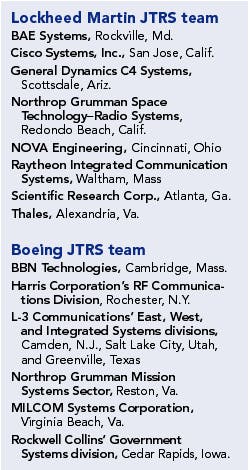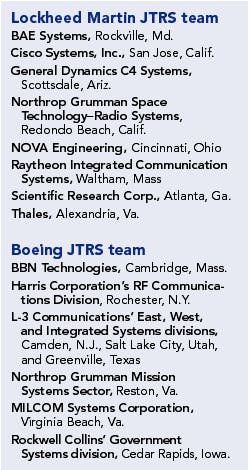Lockheed Martin and Boeing compete for JTRS contract
WASHINGTON — Pentagon leaders took another step toward switching on their Global Information Grid when they awarded competing contracts to Lockheed Martin and Boeing for the Joint Tactical Radio System (JTRS).
The $1 billion JTRS network will replace stovepipe radio frequency communications with software-defined radio in the 2-MHz to 2-GHz spectrum, with room for growth above that. Battlefield commanders will use the new network to trade voice, data, and video between air, maritime, and fixed stations worldwide.
The new contract grants Lockheed Martin a 15-month, $51 million deal to complete the pre-system development and demonstration (pre-SDD) phase of the Airborne and Maritime/Fixed Station Joint Tactical Radio System (AMF JTRS). The contract also grants the Boeing Co. a 15-month, $54.6 million deal for the same phase.
The program is under joint U.S. Air Force and U.S. Navy oversight, with contracts awarded by the Air Force's Electronic Systems Center at Hanscom Air Force Base, Mass. Planners expect to award a single contract for the SDD phase by November 2005.
"These new capabilities will enable net-centric operations and deliver 'knowledge to the node,' directly to warfighters," says Stan Sloane, Lockheed Martin Executive Vice President for the Integrated Systems & Solutions business area in Gaithersburg, Md.
"Our horizontally integrated team brings relevant air and maritime experience to ensure economical platform integration — the essential element in achieving the JTRS transformational vision."
Lockheed Martin leaders have assembled a team to contribute the core technologies. Major members include BAE Systems, Rockville, Md., General Dynamics C4 Systems, Scottsdale, Ariz., Northrop Grumman Space Technology–Radio Systems, Redondo Beach, Calif., and Raytheon Integrated Communication Systems, Waltham, Mass. Additional members are Cisco Systems, Inc., San Jose, Calif., NOVA Engineering, Cincinnati, Ohio, Scientific Research Corp., Atlanta, Ga., and Thales, Alexandria, Va.
"We have the team expertise to transform AMF JTRS from the 'looks good on paper' phase to 'works well in the real world' implementation," says Domenic Costa, Lockheed Martin's vice president for JTRS Programs.
"JTRS is a much-needed transformational initiative that will enable greater battlespace awareness, lethality and higher survivability."
The Boeing AMF JTRS team includes BBN Technologies of Cambridge, Mass.; the Harris RF Communications Division of Rochester, N.Y.; L-3 Communications East, West, and Integrated Systems divisions of Camden, N.J., Salt Lake City, Utah, and Greenville, Texas; Northrop Grumman Mission Systems sector of Reston, Va.; MILCOM Systems Corp. of Virginia Beach, Va.; and the Rockwell Collins Government Systems division of Cedar Rapids, Iowa.
"We have established a premier team of industry experts with unparalleled qualifications who understand operational requirements, offer a low-risk, affordable approach, and are committed to delivering an innovative design that will take the joint services to the next step in networked communications," says Jake Volkert, vice president of the Boeing Battle Management/Command, Control, Communications (BMC3) & Strategic Systems in St. Louis.
Boeing first won a contract in June 2002 to develop the first procurement of JTRS radios for the Army under the Cluster 1 program, and is on track to begin Early Operational Assessment in December 2004.
Under the terms of the new, pre-SDD contract, Boeing will serve as prime systems integrator, responsible for program management, systems and software engineering, network architecture development, airborne platform integration, and integrated logistics support.
Team members Rockwell and Harris are the two radio houses responsible for development of the JTRS and ancillary items. Rockwell will be responsible for radio design, fixed-site radio integration, and platform integration support. Harris will be responsible for radio design, information assurance, maritime radio system integration, and platform integration activities.
L-3 will be responsible for maritime platform integration, the control and management subsystem, specific airborne integration, and airborne network support. Northrop Grumman will be responsible for network management. BBN will build a comprehensive, seamless wireless network architecture, and MILCOM will perform maritime installation support.

